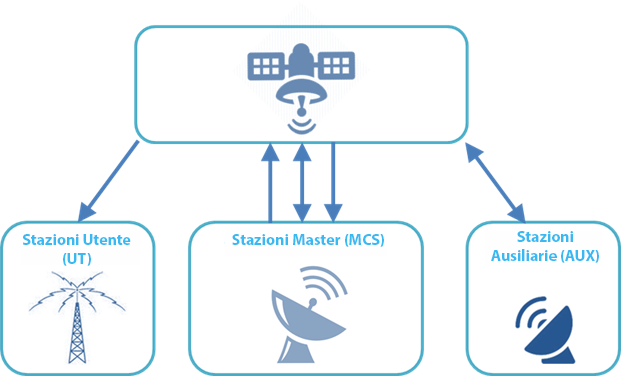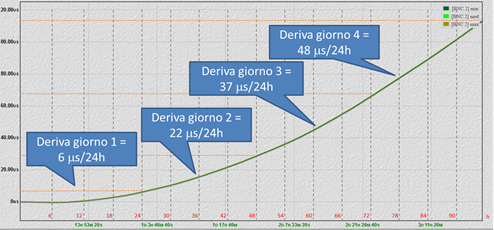Valutazione di laboratorio del sistema Demetra per la distribuzione dei riferimenti tempo/frequenza mediante satellite geostazionario
Una rete di trasmettitori DTT a singola frequenza richiede un riferimento tempo-frequenza che sia disponibile ed unico in tutte le stazioni interessate della rete [1]. Fino ad oggi il GPS, che soddisfa i requisiti di cui sopra, è il sistema comunemente utilizzato; tuttavia, il GPS è una sorgente di sincronizzazione fornita senza alcuna garanzia, ed è controllata da un soggetto terzo non vincolato da alcun contratto. I problemi legati alla sincronizzazione tramite GPS, e GNSS in genere (interferenze, anche intenzionali, dipendenza dall’ente erogatore ecc.) sono ben noti agli operatori broadcast.
Al fine di garantire la continuità del servizio broadcast, le principali emittenti nazionali sono interessate alla ricerca di soluzioni complementari, per disporre di un sistema di sincronizzazione affidabile e preciso.
Con il sistema DEMETRA i riferimenti di tempo e di frequenza vengono distribuiti tramite un satellite geostazionario non dedicato. La tecnologia proposta, che si basa su tecniche di telecomunicazione consolidate (FDMA), permette la disseminazione dei riferimenti tempo e frequenza utilizzando un normale satellite geostazionario e un insieme di stazioni satellitari di servizio per la stima e la trasmissione dei dati di correzione. Il corretto allineamento di tempo si basa sulla trasmissione di un segnale che contiene informazioni di timing, la localizzazione delle stazioni riceventi e la posizione istantanea effettiva del satellite (come noto, i satelliti geostazionari sono affetti da (piccole o grandi) fluttuazioni della posizione rispetto al nominale, dovuti a errori dell’orbita, interazioni gravitazionali con luna e sole, vento solare, ecc.)
Il sistema proposto non richiede satelliti dedicati e, grazie all’uso di una banda spettrale differente da quella impiegata dai sistemi GNSS, permette una sensibile riduzione dei disturbi dovuti alle interferenze.
Questo sistema è destinato comunque a lavorare in parallelo con i sistemi GPS e GALILEO ottenendo così una completa ridondanza tecnologica: ciò è particolarmente adatto per le reti DTT SFN, che richiedono elevata affidabilità ed una precisione di temporizzazione dell’ordine dei 100ns.
Nell’ambito del progetto DEMETRA, finanziato dal programma Horizon2020, che vede come capofila l’Istituto Nazionale di Metrologia (INRIM) di Torino, Antares S.c.ar.l. ha sviluppato un dimostratore per la sincronizzazione di Tempo e Frequenza, alternativo a GNSS (Global Navigation Satellite System), destinato ad utenti professionali che necessitano di precisione di timing nell’ordine dei nanosecondi, quindi più che adeguato per il caso di reti di trasmettitori broadcast.

Lo scopo dei test è stato quello di verificare la possibilità di utilizzare i riferimenti tempo/frequenza distribuiti tramite satellite geostazionario, secondo le modalità ideate e sviluppate all’interno del progetto Demetra (nel seguito “Rif Demetra) per affiancare e/o sostituire quanto oggi è ottenuto mediante il GPS (nel seguito “Rif GPS”) nelle applicazioni utilizzate da Rai. In particolar modo si vuole provare ad utilizzare i Rif Demetra in una rete di trasmettitori DTT a singola frequenza (SFN) [1] in cui parte dei modulatori utilizzano i convenzionali Rif GPS. Per raggiungere tale scopo è stato allestito un opportuno banco di misura che ha permesso inoltre di verificare lo scostamento del Rif Demetra rispetto ad un convenzionale Rif GPS mediante il fasometro, un apparato appositamente ideato per questo genere di misure.
In estrema sintesi si può affermare che il sistema, pur essendo ancora in una fase prototipale, ha evidenziato delle prestazioni molto promettenti. Il sistema, in condizioni operative normali, permette effettivamente di ottenere una precisone del timing in linea con quanto preventivato dagli ideatori/sviluppatori, più che sufficiente per le applicazioni broadcast. I riferimenti di tempo/frequenza ottenuti permettono di allestire una rete DTT a singola frequenza sia nel caso di utilizzo esclusivo (timing “solo Demetra”) sia nel caso in cui si utilizzino timing misti GPS/Demetra.
In condizione di Holdover la deriva del timing è comunque risultata di un ordine di grandezza inferiore rispetto a quanto ottenuto su apparati GPS professionali analizzati a suo tempo, cosa che denota un oscillatore interno di qualità elevata.
La criticità riscontrata sul sistema, nell’ambito di un suo utilizzo per reti SFN, riguarda la presenza di alcune “sbandate” al riaggancio del segnale satellitare che presumibilmente potrebbero essere dovute a una gestione dell’oscillatore non ancora ben ottimizzata. Inoltre, si è notato che la velocità di ripristino dell’allineamento a seguito di un evento di Holdover risulta eccessiva: questo denota una troppo elevata deviazione della frequenza dell’oscillatore a 10MHz, cosa che può causare una eccessiva deviazione della frequenza della portante del trasmettitore, con possibile disservizio. Si ritiene comunque che, nel caso dello specifico utilizzo broadcast, il sistema possa essere facilmente riconfigurato per andare incontro alle esigenze evidenziate.

Ulteriori informazioni
Autori: Andrea Bertella, Fulvio Bonacossa, Bruno Sacco, Mirto Tabone
Riferimenti
[1]. Andrea Bertella, Bruno Sacco, Mirto Tabone, “Reti SFN DVB-T: Q&A (tutto quello che avresti voluto sapere sui trasmettitori SFN e non hai mai osato chiedere…)”. Elettronica e Telecomunicazioni Anno LVII – Numero 2 – Agosto 2008. www.crit.rai.it/eletel/
[2]. Andrea Bertella, Bruno Sacco, Mirto Tabone, Carlo Confalonieri e Aldo Scotti: “Ricevitori GPS per reti SFN – Analisi della stabilità a lungo termine e funzionamento in condizioni di hold over, con verifica del recupero della fase del 10 MHz”. Elettronica e Telecomunicazioni Anno LXI – Numero 1 – Aprile 2012. www.crit.rai.it/eletel/